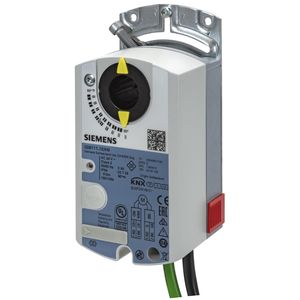
- Heating, Air Conditioning, Electricity
- Switch, socket and electrical equipment
- Home automation system switch actuator
- SIEMENS Building Automation and Control
- Products
- Catalogs
- News & Trends
- Exhibitions
Home automation system switch actuator GSD146.1ADIN railhomecommercial

Add to favorites
Compare this product
Characteristics
- Other characteristics
- for home automation systems
- Installation
- DIN rail
- Market
- home, commercial
- Location
- indoor
Description
Operate direct driven zone dampers used to control air flow in ducts specifically to address two or three-position domestic and light commercial barrel damper applications.
For shaft dia 8...15 mm, square 6...11 mm, min. shaft length 20 mm
With housing made of plastic and 0.9 m connecting cable
Torque
2 Nm
Air damper area
0.3 m²
Angular rotation
90°
Power consumption
2.2 VA, 1.2 W
Positioning time
30 s
Cable length
0.9 m
Positioning signal
Open-close / three-position
Degree of protection
IP54
Ambient temperature, operation
-32...55 °C
Dimensions (W x H x D)
73 x 122 x 63 mm
Operating voltage
AC 24 V, DC 24…48 V
Auxiliary switch
2
Electric motor-driven rotary actuators for open-close, three-position
and modulating control
● 2 Nm nominal torque
● Operating voltage AC 24 V ~ / DC 24…48 V ⎓ or AC 100…240 V ~
● Prewired with 0.9 m connecting cable
● Gear train disengagement button for manual adjustment
● Position indication
● Auxiliary switches for auxiliary functions
The rotary actuator drives the damper to the desired operating position after connecting the
operating voltage.
● Brushless, robust DC motors ensure reliable operation regardless of load.
● The rotary actuators do not require an end position switch, are overload proof, and remain
in place upon reaching the end stop.
● The gears are maintenance free and low noise.
● Simple and reliable shaft integration.
● Mounting bracket included.
Catalogs
No catalogs are available for this product.
See all of SIEMENS Building Automation and Control‘s catalogsOther SIEMENS Building Automation and Control products
Damper Actuators - Standard
Related Searches
- Indoor control module
- Switch actuator
- Home automation system control module
- Indoor switch actuator
- Commercial control module
- Home switch actuator
- DIN rail switch actuator
- Commercial switch actuator
- KNX switch actuator
- IP control module
- Home automation system switch actuator
- Network control module
- DIN rail actuator
- Wireless control module
- Flush-mounted switch actuator
- Built-in switch actuator
- BACnet control module
- WLAN control module
*Prices are pre-tax. They exclude delivery charges and customs duties and do not include additional charges for installation or activation options. Prices are indicative only and may vary by country, with changes to the cost of raw materials and exchange rates.







